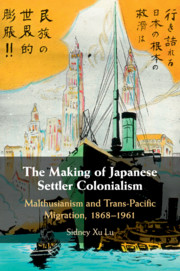Crossref Citations
This Book has been
cited by the following publications. This list is generated based on data provided by Crossref.
Furuhata, Yuriko
2021.
Archipelagic Archives.
Public Culture,
Vol. 33,
Issue. 3,
p.
417.
Homei, Aya
2021.
Birth control survey research, technical bureaucrats and the imagining of Japan’s population, 1945–60.
Japan Forum,
Vol. 33,
Issue. 3,
p.
338.
Klotz, Audie
2021.
Unsettling origin stories.
Cambridge Review of International Affairs,
Vol. 34,
Issue. 6,
p.
867.
Lau-Ozawa, Koji
2021.
Inscriptions and Silences: Challenges of Bearing Witness at the Gila River Incarceration Camp.
International Journal of Historical Archaeology,
Vol. 25,
Issue. 3,
p.
851.
Homei, Aya
and
Matsubara, Yoko
2021.
Critical approaches to reproduction and population in post-war Japan.
Japan Forum,
Vol. 33,
Issue. 3,
p.
307.
Lau-Ozawa, Koji
and
Ross, Douglas
2021.
Critical Mass: Charting a Course for Japanese Diaspora Archaeology.
International Journal of Historical Archaeology,
Vol. 25,
Issue. 3,
p.
577.
Lahti, Janne
2021.
Finnish Colonial Encounters.
p.
95.
Matsusaka, Hiroaki
2022.
Documenting Mobility in the Japanese Empire and Beyond.
p.
153.
Yamamoto, Takahiro
2022.
Documenting Mobility in the Japanese Empire and Beyond.
p.
95.
Wang, Ju-Han Zoe
and
Roche, Gerald
2022.
Urbanizing MinorityMinzuin the PRC: Insights from the Literature on Settler Colonialism.
Modern China,
Vol. 48,
Issue. 3,
p.
593.
GUTH, CHRISTINE M. E.
2022.
Benjamin Smith Lyman and Cosmopolitan Vegetarianism.
Journal of American Studies,
Vol. 56,
Issue. 5,
p.
812.
Yamamoto, Takahiro
2022.
Documenting Mobility in the Japanese Empire and Beyond.
p.
1.
2023.
Waiting for the Cool Moon.
p.
1.
2023.
Waiting for the Cool Moon.
p.
193.
2023.
Waiting for the Cool Moon.
p.
185.
Leung, Shuk Man
2023.
Chinese Settler-Colonialism and the Borderless National Imagination in Lü Sheng’sA Madman’s Dream.
Asian Studies Review,
Vol. 47,
Issue. 3,
p.
500.
Toji, Simone
2023.
Floating sentiments: silence and memory in the encounter between the celebration of Tooro Nagashi and the intangible cultural heritage policy in Brazil.
International Journal of Heritage Studies,
Vol. 29,
Issue. 4,
p.
260.
2023.
Beauty Regimes.
p.
1.
2023.
Beauty Regimes.
p.
19.
2023.
Waiting for the Cool Moon.
p.
60.





